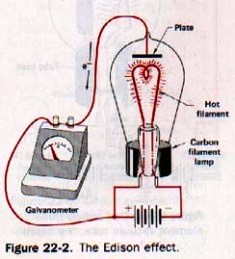Edison Effect
February 13, 1880: Thomas Edison makes another discovery. Thermionic emission is the name for heat-induced flow of charge carriers (in physics, this is a particle that is free to move and carry an electric charge with it) from a surface or over a potential-energy barrier. Today, we know that the charge carriers can be electrons or ions but in older literature they are sometimes called thermions. The classic example of this is the emission of electrons from a hot cathode into a vacuum and it is also known as the Edison effect. The hot cathode can be a metal filament, as in a light bulb.
JJ Thomas identified the electron as a separate physical particle in 1897 so before that time, different words were used to describe the effect seen. In 1873, Frederick Guthrie in Britain initially reported on the phenomenon. It was rediscovered on this day by Edison while he was looking for the reason that a lamp element’s broke with uneven blackening. While working with incandescent lamps, Edison built several bulb with different configurations manipulating the wire or adding a metal plate or foil inside the bulb. He measured the current through various configurations using a galvanometer.
Thomas Alva Edison was born on February 11, 1847 in Milan, Ohio. His work with electricity and the light bulb are the most famous of his many inventions. He also worked on the phonograph and motion picture cameras. He used principles of mass production in his Menlo Park laboratory – what we might call a Think Tank today. He owned 1,093 US patents as well as patents in the United Kingdom, France, and Germany. While that is impressive in its own right, the impact of many of his patents are even more so. He not only invented things, he created entire new systems such as power utilities and early mass communication modes.
He was the seventh and youngest child in his family. He was not a stellar student and did not pay close attention to the teacher who called him “addled”. He survived just three months of classroom instruction after which time his mother took over his education. He was an avid reader and left to his own devices, could learn much from what he read. He suffered hearing loss as a child, perhaps from scarlet fever or recurrent middle-ear infections. Or else he lost his hearing when he was thumped on the side of the head by an irate railroad worker after one of Edison’s experiments blew up on the train. He sold fruits and vegetables on trains to supplement his income. Finally, Edison obtained exclusive right to sell newspapers on the road, his first of many entrepreneurial ventures which continued throughout his life. He died at the age of 82 in West Orange, New Jersey.
Our greatest weakness lies in giving up. The most certain way to succeed is always to try just one more time.
I have friends in overalls whose friendship I would not swap for the favor of the kings of the world.
If we did all the things we are capable of, we would literally astound ourselves.
Hell, there are no rules here – we’re trying to accomplish something. – all from Thomas A. Edison
Also on this day: The Center of the Universe – In 1633, Galileo was brought before the Inquisition.
Charlie Brown and the Gang – In 2000, the last original Peanuts cartoon was run.
That’s Debatable – In 1815, The Cambridge Union Society is founded.
Old MacDonald – In 1692, the Glencoe Massacre took place.

leave a comment